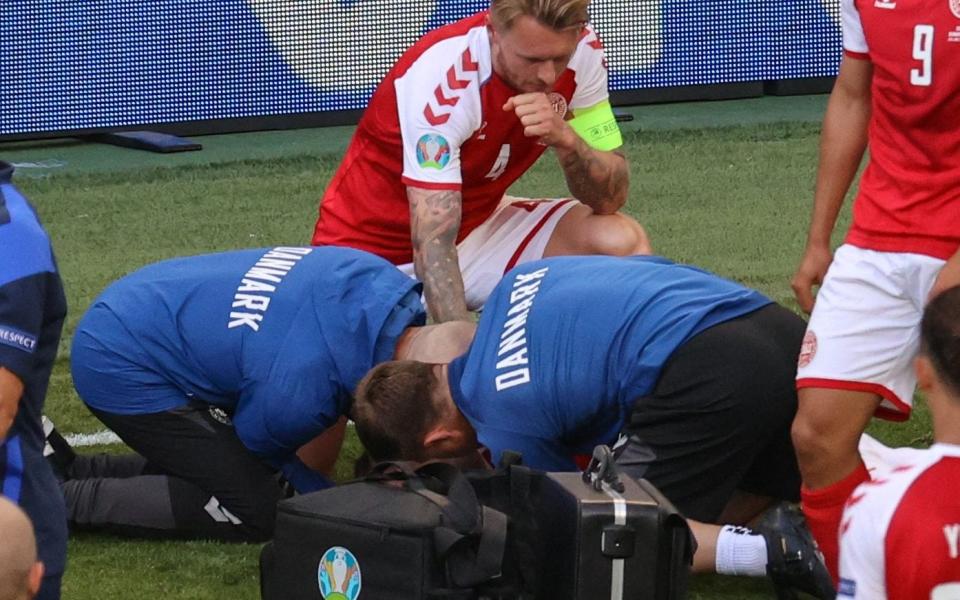Christian Eriksen collapse: Simon Kjaer and his team-mates’ protective shield was team spirit at its most stirring

Of all the images from a chilling night in Copenhagen, perhaps the most abiding was the extraordinary nimbleness of the medical response that saved Christian Eriksen’s life. From the intervention of his Danish team-mate Simon Kjaer, making sure that he was in the recovery position and that he did not swallow his tongue while unconscious, to the pitchside paramedics who helped usher him from Parken Stadium to Rigshospitalet within minutes, the reaction was an object lesson in how to mobilise when football’s worst horror materialises from a clear blue sky.
When Fabrice Muamba went into cardiac arrest and collapsed at White Hart Lane nine years ago, the shock sprang in part from the event’s extraordinary rarity. It is to the game’s immense credit, then, that it recognised that such scenes would happen again, even if it could not say how or when. Nobody in the stands, let alone the millions around the world, supposed that the dreaded moment would arrive in the 43rd minute of a somnolent goalless draw between Denmark and Finland. One of football’s great strengths, though, is that it plans for every eventuality, no matter how ghastly or outlandish.
Not long after the Premier League held its breath over Muamba, Arsene Wenger predicted that such a deeply disquieting incident would change the sport for the better. “Does football need to go in deeper with research, or deeper in control with heart problems, to stop these kinds of situations?,” the Frenchman asked. “You can always learn something out of these types of situations.”
Eriksen, not that he carried any known pre-existing cardiac issue at 29, was clearly a beneficiary of football’s resolve to learn from the Muamba case. It took mere seconds for Kjaer to suppress the shock of seeing his friend prone on the turf for him to summon the initial medical help. When the trauma of these sights eventually subside, it will be to the Milan centre-back that one of the most significant debts of gratitude is owed.
Not only did he have the presence of mind to handle Eriksen’s stricken body, he also guided the rest of the Danish team to form a protective shield around the area and later headed to comfort the midfielder’s wife, Sabrina, hugging her and persuading her not to come on to the pitch. It was a display of quick thinking that commanded the deepest respect.
One day, the picture of that tightly-bunched guard of players, many of their faces betraying a profound anguish, will come to be cited among the most stirring exhibitions of team spirit summoned in the name of sport.
Kjaer (right, with Finland’s Teemu Pukki before the restart), in particular, set in train the responses to an emergency that could have had a far graver outcome. But there must be acknowledgement, too, for the medics who administered the cardio-pulmonary resuscitation (CPR), and who saw to it that a player whose life hung in the balance at 5.43pm was pronounced awake by the Danish federation 48 minutes later.
This was one occasion where honour deserved to be spread far and wide, from referee Anthony Taylor to the players, from the doctors to the physiotherapists, for their roles in bringing Eriksen back.
Gary Lewin, the former England physiotherapist, is one well-versed in acting quickly when life-or-death situations manifest themselves mid-match.
In 1989, having seen David Rocastle in evident distress after his airway became blocked with his tongue, he rushed on to the field to perform the necessary treatment. After he was called to John Terry’s aid in similar circumstances in the 2007 League Cup final, the Chelsea captain credited him with saving his life.
Lewin on Saturday night described how improvements in the game’s medical procedures had rescued Eriksen from a grislier fate. “The medical team will have gone into what we call the ‘emergency action plan,’” he explained.
“Once they stabilised him, they would have got him into the cardiac position as soon as they possibly could. The picture of him leaving the ground with oxygen was a sign that the action taken by the medical team was very quick and very efficient. All I can say is what an amazing job they all did.”
It was also the sharpest reminder of the necessity for all teams, at no matter what level, to have a defibrillator close by and the people with the training to use it. In Danish schools, it is compulsory to learn CPR, a policy believed to have tripled survival rates from heart attack in the country. Many of the players evidently knew exactly what to do the second they noticed Eriksen in such danger.
What could have been one of football’s darkest days turned out, in the fraught nightmare of one Copenhagen evening, to be one of its noblest.

 Yahoo Finance
Yahoo Finance 